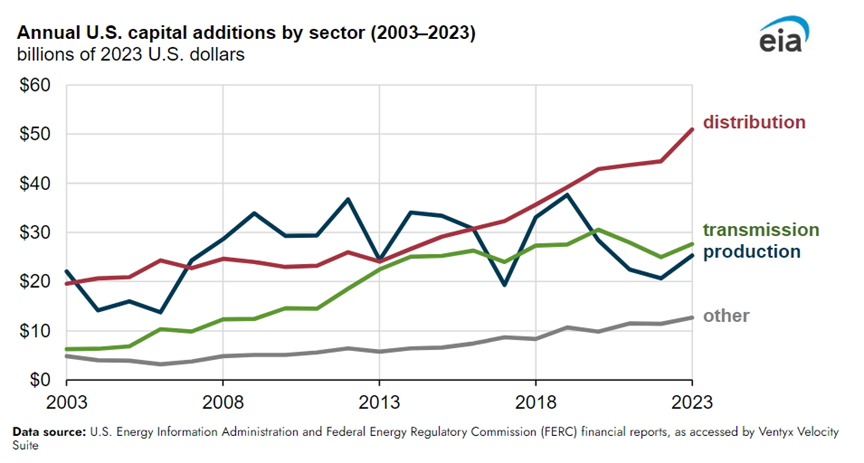
Lori Aniti of the US Energy Information Administration reports that grid infrastructure investments have increased utility spending over the last two decades. Aniti writes:
Annual spending by major utilities to produce and deliver electricity increased 12% from $287 billion in 2003 to $320 billion in 2023 as measured in real 2023 dollars, according to financial reports to the Federal Energy Regulatory Commission (FERC). Capital investment in electric infrastructure mostly drove the increase, more than doubling over the period as:
- Aging generation and delivery infrastructure were replaced or upgraded to resist fire and storm damage.
- Utilities installed first natural gas-fired generation, then wind and solar generation, and, more recently, battery storage.
- New lines were connected to renewable resources.
- New technology, including smart meters, sensors, and automated controls, was added to the system.
Distribution
Capital spending on the distribution system, responsible for delivering electricity to end users, was the main driver of electricity spending increases over the last two decades. Capital investment in distribution infrastructure increased by $31.4 billion, or 160%, from 2003 to 2023.More than one-fifth of this increase occurred between 2022 and 2023 when spending increased by $6.5 billion to a total of $50.9 billion as utilities replaced and upgraded aging equipment and installed new lines, transformers, and other equipment to help neighborhood electricity grids withstand extreme weather events and to manage the intermittency of renewable resources.
Capital spending on overhead lines, poles, and towers increased the most. Utilities spent $17.4 billion on overhead infrastructure in 2023, an 11% increase from 2022 and a 220% increase from 2003. […]
Although energy storage remains a relatively small portion of the total budget for distribution infrastructure, spending increased from $97 million in 2022 to $723 million in 2023. Energy storage at the substation or customer site enhances power quality and provides backup power in areas where lines and transformers cannot handle additional capacity, especially as more intermittent renewable resources come online.
Read more here.





